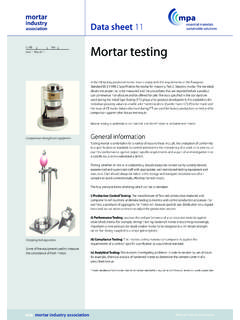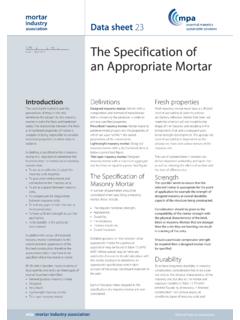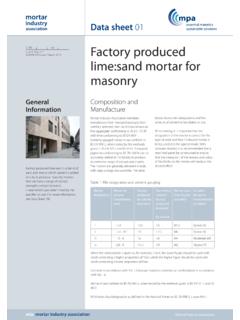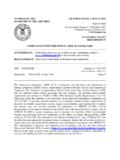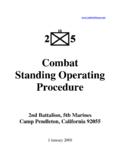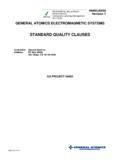Transcription of Learning Text Part 9 Specifications
1 SpecificationsMacintosh HD:Users:jennycarr:Desktop:extras:LT - Specifications # Page 1 of 2124thApril 2007 Learning TextPart 9 SpecificationsSpecificationsMacintosh HD:Users:jennycarr:Desktop:extras:LT - Specifications # Page 2 of 2124thApril 2007 Contents PageIntroduction 3 Historical 3 The functions of masonry mortar 3 Design requirements 4 Strength and stability (structural requirements) 4 Weather resistance5 Durability 5 Fire resistance6 Thermal insulation7 Sound insulation 7 Methods of specifying masonry mortar7 General7 Prescribed masonry mortars7 Designed masonry mortars8 specification drafting9 The functions of rendering mortar10 Design requirements10 Background10 Durability 12 Methods of specifying rendering mortar 13 Prescribed rendering mortars 13 Designed rendering mortars 14 Glossary of terms16 Bibliography 19 Self-Assessment Questions20
2 Answers to Self-Assessment Questions 21 SpecificationsMacintosh HD:Users:jennycarr:Desktop:extras:LT - Specifications # Page 3 of 2124thApril 2007 IntroductionThis Learning text considers the subject of the specification of masonry and renderingmortars. The text discusses the historical evolution of Specifications and currentrequirements. Information is given on the parameters that need to be considered in thepreparation of a specification . A glossary of terminology and bibliography are included.
3 Thefinal section of this Learning text is self-assessment questions and earliest documented use of mortar is around 4000 It is mentioned several times inthe old testament of the bible. However, it was the Romans who really developed itsstructural use. Vitrivius a military engineer who worked under Julius Caesar wrote aspecification for sand, lime and bricks to be used in masonry. He stated, In buildings ofrubble work it is of the first importance that the sand be fit for mixing with the lime, andunalloyed with earth.
4 He further stated though pit sand is excellent for mortar, it is unfitfor plastering for being such a rich quality, when added to the lime and straw, its greatstrength does not suffer it to dry without cracks .Historically, mortars have been specified on a volume basis, probably because they havealmost always been mixed on site by the shovelfull, for example one shovelful of cement orlime to perhaps three or six shovelfuls of sand (fine aggregate). This would be written inspecification terms as a 1 : 3 or a 1.
5 Term specification may be defined in relation to construction as, a document containing adetailed description of the particulars of some projected work in building, engineering orsimilar, giving the dimensions, materials, quantities etc, of the work together with directionsto be followed by the builder or functions of masonry mortarPrior to specifying masonry mortar it is very important to understand how the constituentmaterials determine the fresh and hardened properties of the mortar and how the mortarcontributes to the successful performance of the masonry.
6 Masonry mortar has a number offunctions: To act as an adhesive (to glue) the masonry units together, To glue joint reinforcement and connectors to the masonry units, To act as a spacer between masonry units, To compensate for irregularities between masonry units, To seal any gaps to minimise rain or wind penetration, To have sufficient strength to suit the application, To be durable in the particular addition the colour of hardened masonry mortar contributes to the overall aestheticappearance of the finished construction.
7 Therefore the colour of the mortar and the method offinishing (workmanship) need to be considered when drafting the Learning text entitled Properties of Masonry Mortar ( Learning Text 6) discusses thedesirable qualities for a masonry mortar in greater requirementsSpecificationsMacintosh HD:Users:jennycarr:Desktop:extras:LT - Specifications # Page 4 of 2124thApril 2007 Drafting a specification is a complex matter, many parameters have to be taken into account,this section of the Learning text discusses a number of the factors that have to be considered inthe compilation of the design of masonry construction is covered by BS 5628-3; clause 5 entitled Design liststhe factors that should be taken into account.
8 The statement is made that Considerationshould be given to the interaction of the whole structure, of which the masonry forms a part .This statement highlights the importance of not considering masonry and mortar in isolationfrom the other building components. Parts 1 and 2 of BS 5628 provide further guidance forthe designer of the masonry and mortar, on the parameters to be considered in the preparationof the specification for particular construction applications and parameters to be considered in drafting a specification for masonry include.
9 Strength and stability, Weather resistance, Durability, Fire resistance, Thermal insulation, Sound of these parameters is now briefly and stability (structural requirements)A large percentage of masonry construction is in the form of walls for houses or walls andpiers for other buildings. These together with the roof form the environmental envelope of thebuilding, the walls very frequently become the basic supporting designer of a masonry construction is required to consider the forces acting on theelement being designed, these include.
10 The thickness in relation to the height and width of the construction, The weight of the element, The presence of piers, The application of concentrated loads to walls, The application of lateral loads to walls ( wind), Movement, The interaction with other construction of these factors enables the designer to determine the most suitable form ofconstruction and the range of materials that may be HD:Users:jennycarr:Desktop:extras:LT - Specifications # Page 5 of 2124thApril 2007 Weather resistanceThe external walls of a building are required to provide adequate resistance to wind and rainpenetration.
